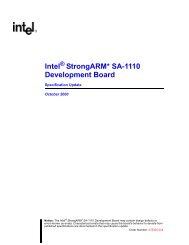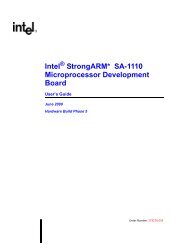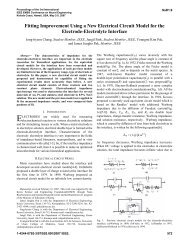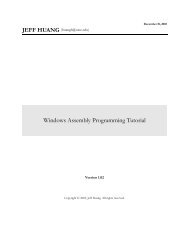Beej's Guide to Network Programming Using Internet Sockets
Beej's Guide to Network Programming Using Internet Sockets
Beej's Guide to Network Programming Using Internet Sockets
- No tags were found...
You also want an ePaper? Increase the reach of your titles
YUMPU automatically turns print PDFs into web optimized ePapers that Google loves.
Beej’s <strong>Guide</strong> <strong>to</strong> <strong>Network</strong> <strong>Programming</strong> <strong>Using</strong> <strong>Internet</strong> <strong>Sockets</strong> 8struct in_addr {unsigned long s_addr; // that’s a 32-bit long, or 4 bytes};Well, it used <strong>to</strong> be a union, but now those days seem <strong>to</strong> be gone. Good riddance. So if you havedeclared ina <strong>to</strong> be of type struct sockaddr_in, then ina.sin_addr.s_addr references the4-byte IP address (in <strong>Network</strong> Byte Order). Note that even if your system still uses the God-awfulunion for struct in_addr, you can still reference the 4-byte IP address in exactly the same wayas I did above (this due <strong>to</strong> #defines.)3.1. Convert the Natives!We’ve now been lead right in<strong>to</strong> the next section. There’s been <strong>to</strong>o much talk about this <strong>Network</strong><strong>to</strong> Host Byte Order conversion–now is the time for action!All righty. There are two types that you can convert: short (two bytes) and long (four bytes).These functions work for the unsigned variations as well. Say you want <strong>to</strong> convert a short fromHost Byte Order <strong>to</strong> <strong>Network</strong> Byte Order. Start with “h” for “host”, follow it with “<strong>to</strong>”, then “n” for“network”, and “s” for “short”: h-<strong>to</strong>-n-s, or h<strong>to</strong>ns() (read: “Host <strong>to</strong> <strong>Network</strong> Short”).It’s almost <strong>to</strong>o easy...You can use every combination of “n”, “h”, “s”, and “l” you want, not counting the reallystupid ones. For example, there is NOT a s<strong>to</strong>lh() (“Short <strong>to</strong> Long Host”) function–not at thisparty, anyway. But there are:• h<strong>to</strong>ns() – “Host <strong>to</strong> <strong>Network</strong> Short”• h<strong>to</strong>nl() – “Host <strong>to</strong> <strong>Network</strong> Long”• n<strong>to</strong>hs() – “<strong>Network</strong> <strong>to</strong> Host Short”• n<strong>to</strong>hl() – “<strong>Network</strong> <strong>to</strong> Host Long”Now, you may think you’re wising up <strong>to</strong> this. You might think, “What do I do if I have <strong>to</strong>change byte order on a char?” Then you might think, “Uh, never mind.” You might also thinkthat since your 68000 machine already uses network byte order, you don’t have <strong>to</strong> call h<strong>to</strong>nl()on your IP addresses. You would be right, BUT if you try <strong>to</strong> port <strong>to</strong> a machine that has reversenetwork byte order, your program will fail. Be portable! This is a Unix world! (As much as BillGates would like <strong>to</strong> think otherwise.) Remember: put your bytes in <strong>Network</strong> Byte Order beforeyou put them on the network.A final point: why do sin_addr and sin_port need <strong>to</strong> be in <strong>Network</strong> Byte Order in astruct sockaddr_in, but sin_family does not? The answer: sin_addr and sin_port getencapsulated in the packet at the IP and UDP layers, respectively. Thus, they must be in <strong>Network</strong>Byte Order. However, the sin_family field is only used by the kernel <strong>to</strong> determine what type ofaddress the structure contains, so it must be in Host Byte Order. Also, since sin_family does notget sent out on the network, it can be in Host Byte Order.3.2. IP Addresses and How <strong>to</strong> Deal With ThemFortunately for you, there are a bunch of functions that allow you <strong>to</strong> manipulate IP addresses.No need <strong>to</strong> figure them out by hand and stuff them in a long with the












